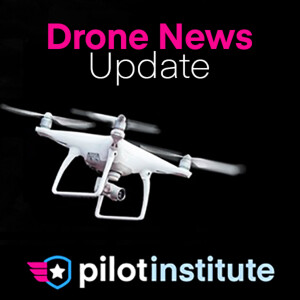

Drone News Update
https://anchor.fm/s/2a45d2b8/podcast/rssEpisode List

Drone News: Part 108 NPRM, Update on Drone Collision in TX, and Major Leaks on DJI Mini 5 Pro
Welcome to your weekly UAS News Update. We have three stories for you this week: The FAA has finally unveiled its proposed rule for Beyond Visual Line of Sight operations, an update to the story about a drone collision in Kerrville Texas, and we have some major leaks about the DJI Mini 5 ProThe FAA has released its Notice of Proposed Rulemaking, or NPRM, for Beyond Visual Line of Sight, or BVLOS, operations. This is a massive deal for our drone industry. For years, complex BVLOS operations have required a slow, case-by-case waiver process. This new rule aims to create a standardized, scalable framework to normalize these flights. The proposal is designed to unlock the economic potential of drones in areas like package delivery, agriculture, and infrastructure inspection.So, what's in the proposal? There’s a ton. We’re working on a full video debrief of the NPRM now, but here are some points: • Operations will be at or below 400 feet, • Aircraft up to 1,320 lbs, • All operators would need FAA approval for the area where they intend to fly. They would identify the boundaries and the approximate number of daily operations, as well as takeoff, landing, and loading areas, if applicable, • All drones would need Remote ID and lighting, • BVLOS drones could be operated over people in different situations, • There are security requirements for BVLOS operators, • BVLOS operators may not need ANY FAA certificates.What we haven’t seen in the NPRM so far is: • Any mention of network remote ID, • and any mention of extended visual line of sight for Part 107 operators.Next up, An update to the Helicopter and Drone mid-air out of Kerrville, Texas last month.During the catastrophic floods in Kerrville, Texas, on July 7th, a military UH-60 Black Hawk helicopter was forced to make an emergency landing after colliding with a drone. Initial reports immediately blamed an unauthorized civilian drone violating the active Temporary Flight Restriction, or TFR. We reported this as it was reported by others, stating that the drone appeared to be an unauthorized flight in the TFR.However, testimony at a state hearing later clarified what really happened. The drone involved was actually an AUTHORIZED search and rescue drone that is alleged to have malfunctioned. According to the report, it “flew too high, stalled, and then collided with the helicopter”. Last up are some DJI leaks! It looks like we're getting our first real glimpse of the DJI Mini 5 Pro, thanks to some leaked images of the product box and a new render. And if these specs are real, this could be a game-changer for the mini drone category. The box confirms a 1-inch image sensor capable of shooting up to 4K/120fps video. That would be quite an upgrade from the 1/1.3-inch sensor in the Mini 4 Pro. The leak also points to a gimbal with 225 degrees of rotation for more flexible camera movements, a 48mm medium-telephoto mode, and Nightscape Omnidirectional Obstacle Sensing that uses a forward-facing LiDAR sensor. But here's the most important detail, and it's what's MISSING from the box. The Mini 4 Pro box clearly stated "Less Than 249 g," but that text is nowhere to be found on this new leak. With a bigger sensor and a LiDAR unit, it's very possible the Mini 5 Pro will tip the scales over that magic 250-gram mark. This would have major implications for pilots who rely on the regulatory freedom of the sub-250g category. https://dronexl.co/2025/08/05/faa-unveils-proposed-bvlos-rule-drone/https://dronexl.co/2025/08/03/dji-mini-5-pro-key-features-box-confirms/https://dronexl.co/2025/07/31/authorized-drone-disrupts-rescue-helicopter-kerrville/

Drone News: Insta360's New Drone, Neo 2 Spotted in FCC Filings, CEO Pushes for Airspace Credentials
Welcome back to your Weekly UAS News Update. We've got three stories for you this week. First, the Neo 2 has been spotted in FCC filings, Insta360 is jumping into the drone game with a new brand called Antigravity, and the CEO of DroneUp seems to be pushing for digital airspace authorizations.First up, it looks like DJI might have some serious new competition. Insta360, the company known for its 360-degree cameras, has launched a new drone brand called Antigravity. And their first drone sounds pretty revolutionary: it's reportedly the world's first 360-degree drone that weighs less than 249 grams and can shoot in 8K.Antigravity says its focus isn't on raw specs, but on creating an "immersive flight" experience that makes storytelling easy for everyone, from beginners to experts. The drone will reportedly include smart safety features, like payload detection to deter misuse or modifications. The full, official unveiling is scheduled for this August. We've seen other companies like GoPro and Skydio struggle to challenge DJI's dominance, so it will be interesting to see if Insta360 and Antigravity’s approach.Next up, a new DJI drone, the Neo 2, has surfaced on the FCC website, which is usually the first major step before a product can be sold in the US. The filing reveals a notable upgrade: a 1606 milliamp-hour battery, which is about a 12% increase from the original Neo. This should translate to longer flight times than the original's 18 minutes. While FCC approval is a promising sign, it doesn't guarantee the Neo 2 will be available in the US. Since last October, US Customs has been detaining some DJI shipments, citing the Uyghur Forced Labor Prevention Act. DJI firmly disputes any connection to forced labor, but the issue has already prevented the official US release of other products, like the Mavic 4 Pro. So, even with the FCC's green light, the Neo 2's future in the American market remains uncertain.And finally, Tom Walker, the CEO of DroneUp, published an opinion piece for Fox News where he pointed to a recent, dangerous incident during the Texas floods. A private drone reportedly collided with a rescue helicopter, forcing the crew to land and grounding a vital asset during a life-or-death situation.Walker says this isn't an isolated problem. He cited FAA data showing that illegal drone incursions near US airports jumped by 25% in the first quarter of this year compared to 2024. He warns that our current systems for detecting and responding to these threats are, in his words, "fractured, outdated, and dangerously inadequate."So what's the solution? Walker wants a unified, real-time tracking system for all low-altitude air traffic. He's also pushing for secure digital credentials to link drones to their pilots, and for expanding the authority of local law enforcement to counter drone threats. He argues that the technology to do this already exists, but says we need to act now before one of these incidents becomes a national tragedy.I can tell you that we at Pilot Institute will oppose any sort of technology that introduces ANY cost to access the national airspace system. Access to the NAS must remain free for ANY and ALL users. We’ll be watching this closely. And on Postflight, our show where we share our opinions in the premium community, we’ll discuss the SkyRover X1 and how drones are being used to drop mosquitos in Hawaii. We’ll see you on Monday for the live and for post flight in the community! https://dronedj.com/2025/07/25/dji-neo-2-drone-fcc/https://dronexl.co/2025/07/28/insta360-antigravity-drone-360-8k/https://dronexl.co/2025/07/21/drone-ceo-warns-of-escalating-airspace-risks/

Drone News: DEXA Secures Nationwide BVLOS, DroneDeploy's Progress AI, Drone Pilot Finds Missing Girl
Welcome to your weekly UAS News Update. We have three stories for you this week. First, DEXA secures a nationwide BVLOS waiver for drone deliveries, DroneDeploy launches Progress AI, and a drone pilot finds a missing girl in Wisconsin. First up, U.S. drone delivery company DEXA has hit a major regulatory milestone, securing a nationwide Beyond Visual Line of Sight, or BVLOS, waiver from the FAA. This is a huge deal because it allows the company to conduct autonomous delivery operations across the country without needing visual observers on the ground for every flight. This approval puts DEXA in an elite group alongside giants like Amazon Prime Air, Wing, and Zipline, who are all pushing the boundaries of commercial drone logistics.In addition to this new BVLOS waiver, the company already holds a Part 135 Air Carrier Certificate, which legally allows them to run a drone airline. They also have an airworthiness certification for their DE-2020 delivery drone. Having all three of these in place is the key to unlocking scalable, repeatable, and, most importantly, profitable drone delivery services. They're using their own U.S.-made aircraft and a direct-to-consumer app called DEXA NOW. Next up, DroneDeploy has just announced a new tool that called Progress AI, and it's designed to completely automate construction progress tracking. Instead of someone walking a site with a clipboard and manually marking up drawings, this system uses AI to analyze data from drones and 360-degree cameras to generate fast and reliable progress reports. DroneDeploy claims the platform can deliver reports with 95% accuracy within minutes of the images being uploaded.One of the coolest features is its natural-language interface. This works without needing a complex Building Information Model, or BIM, which lowers the barrier to entry for a lot of companies. Early users are already reporting great results, with one project engineer saying they caught a framing issue with a door install just by reviewing a walkthrough, saving them days of rework. Progress AI is currently in early access and is expected to be widely available in October as an add-on for DroneDeploy customers. Last up, a real-world drones-for-good story! A volunteer drone pilot in Milton, Wisconsin, is being called a hero after he found a missing 4-year-old girl in a dense cornfield. The girl, Lou Easton, is autistic, nonverbal, and reportedly doesn't feel pain, which made her disappearance incredibly urgent. With sunset approaching, her family feared she had wandered into a nearby cornfield. That's when Rock County officials called for aerial support.The hero of the day is Jeremy Harring-Spoerl, a volunteer with Wisco Aerial and Ground Services. He launched his DJI Matrice 30 drone and got to work. In just 40 minutes, he spotted Lou deep in the cornfield and was able to guide rescue teams directly to her location. She was found safe and unharmed. This is a perfect example of why drones are such incredible tools for search and rescue. A drone can cover a massive area far more quickly than a ground team, and thermal cameras can spot heat signatures that would be impossible to see otherwise. Stories like this are a powerful reminder that for every headline about drone bans, there are pilots out there using this technology to save lives. A huge congratulations to Jeremy for a job well done!Alright, and the team will be back from Oshkosh next week, so no Live on Monday or Post flight this coming week, but we’ll pick back up the following! https://dronexl.co/2025/07/14/dexa-faa-bvlos-waiver-drone-deliveries/https://dronexl.co/2025/07/21/drone-hero-saves-missing-girl-wisconsin/https://dronelife.com/2025/07/22/dronedeploy-launches-progress-ai-to-automate-construction-tracking/

Drone News: DOC Investigation, Expedited Audit, Amendment to Audit, New FAA Admin, 3 New DJI Drones
Join our community 👉 https://bit.ly/pilot-institute-communityFirst up, the U.S. Commerce Department has officially launched a Section 232 national security investigation into drones and their components, with a clear focus on Chinese manufacturers . This investigation falls under the Trade Expansion Act of 1962, giving the government the power to recommend tariffs, quotas, or other restrictions if it finds that imported products threaten national security. The probe will look at whether our reliance on foreign-made drones weakens US supply chains and exposes sensitive data.If the ODNI review finds what they call "unacceptable risks," it could trigger rapid regulatory action along with inclusion on the FCC’s Entity list, which would prevent any FCC licenses from being issued. Now, DJI has repeatedly denied any affiliation with the Chinese military, and a 2022 Pentagon audit found no malicious code in their Government Edition drones. However, the lawmakers behind this push argue that audit was limited and is now outdated. This is a developing situation, but a 30-day timeline is extremely aggressive. It’s also very curious that the lawmakers behind the language in the NDAA are the ones pushing for this audit to occur. We’ll keep you updated when we know more. Along the same lines, Representative Stefanik introduced an amendment to the 2026 NDAA that would require all Chinese drone manufacturers to undergo the same security audit as DJI and Autel. And even more news from the US Government, The Senate has confirmed Bryan Bedford as the new FAA Administrator with a 53-43 vote. Bedford is the former CEO of Republic Airways. Next up, DJI rolled out three new agriculture drones for the global market, but not for the US. The new models are the Agras T100, the T70P, and the T25P, each designed for different scales of farming. The Agras T100 is an absolute beast, basically a flying tractor. It can carry a massive 100-liter payload for spraying or 150 liters for spreading. With a top speed of 20 meters per second, it's twice as efficient as its predecessor. The T70P is a step down, designed for mid-sized farms, with a 70-liter spray capacity and a 100-liter spread capacity. It features DJI's new Safety System 3.0, which combines millimeter-wave radar and a Tri-Vision system for better obstacle avoidance in tricky terrain.Finally, there's the Agras T25P, which is built for solo operators or smaller, more complex plots like orchards. It's compact and foldable but still packs a punch with a 20 kg payload and a spray rate of 16 liters per minute. It even allows for adjustable droplet sizes between 50 and 500 micrometers for super precise applications. These drones were actually released in China last year, but their global launch signals a major push by DJI in the agricultural space.And on post flight, our show where we discuss these stories and share our opinions, along with discussing DJI’s FlyCart 30 that’s been operating on Mt Everest this season! We’ll see you there on Monday, on Youtube for Live on Monday, and back here on Friday for news update! https://dronedj.com/2025/07/15/dji-autel-drone-national-security/https://dronedj.com/2025/07/16/dji-agras-new-drone-launch/https://droneadvocacyalliance.com/https://dronexl.co/2025/07/10/natsec-review-chinese-drone-maker-dji/https://dronexl.co/2025/07/09/senate-confirms-bryan-bedford-as-faa-administrator/

Drone News: FAA BVLOS NPRM Missed, Drone Ban Proposal, and Drone Hits Helicopter in TX
First up, it’s another case of "hurry up and wait" for our drone industry. The FAA has missed another major deadline for publishing the much-anticipated Beyond Visual Line of Sight, or BVLOS, Notice of Proposed Rulemaking. This time, the deadline was set by a presidential executive order. On June 6th, 2025, President Trump signed the “Unleashing American Drone Dominance” order, which gave the FAA a very aggressive 30-day timeline to issue the proposed rule. Well, that deadline was July 7th, and it came and went with no NPRM in sight.This new missed deadline joins the one from the FAA Reauthorization Act of 2024, which mandated the NPRM be published by September 16, 2024. A Bit of history: The BVLOS Aviation Rulemaking Committee, or ARC, delivered its comprehensive 381-page report with 70 recommendations all the way back in March of 2022. That report gave the FAA a set of recommendations for enabling BVLOS. Next up, Florida Senator Rick Scott has introduced the "Drones for America Act," a bill aimed at banning Chinese-made drones and their components while trying to boost U.S. manufacturing. The bill proposes a phased approach. It would implement a full ban on the sale of Chinese-manufactured drone systems by January 1, 2028, and a ban on Chinese-made components by January 1, 2031. In the meantime, a gradually increasing tariff would be placed on these items to phase them out of the market. The revenue collected from these tariffs would be used to fund a grant program. This program is designed to help American companies develop and produce U.S.-manufactured drones and components along with helping first responders, law enforcement, and even farmers and ranchers purchase these American-made drones. However, this bill neglects the largest users of drones, small businesses and recreational flyers. Right now, there are no real alternatives to DJI for consumers and small businesses. And we’ve heard from the people who are likely behind this bill that there has been NO study done to determine the output of drones from American Manufacturers. These bill threaten to destroy the drone industry in favor of a few American manufacturers, who don’t even have an interest in making consumer drones. Please reach out to your Senators and Representatives and tell them this is not a good idea. And finally this week, a story that serves as a critical reminder for all of us about why the rules exist. On July 7th, during catastrophic flooding in Kerr County, Texas, a drone reportedly collided with a rescue helicopter. The helicopter was forced to make an emergency landing and is now out of commission. This has sidelined a critical life-saving asset in an area where, tragically, over 100 people have died. The entire area was under a Temporary Flight Restriction, or TFR, specifically NOTAM FDC 5/2615, to keep the airspace clear for these exact types of rescue operations.Alright, we’ll see you on Monday for the Live and for Post Flight in the Premium Community! https://dronelife.com/2025/07/07/another-missed-deadline-the-bvlos-nprm-still-awaits-publication/https://dronexl.co/2025/07/07/drone-fiasco-in-kerr-county/https://www.rickscott.senate.gov/2025/6/sen-rick-scott-introduces-drones-for-america-act-to-ban-chinese-made-drones-components-support-u-s-drone-manufacturing
You may also like
Create Your Podcast In Minutes
- Full-featured podcast site
- Unlimited storage and bandwidth
- Comprehensive podcast stats
- Distribute to Apple Podcasts, Spotify, and more
- Make money with your podcast












